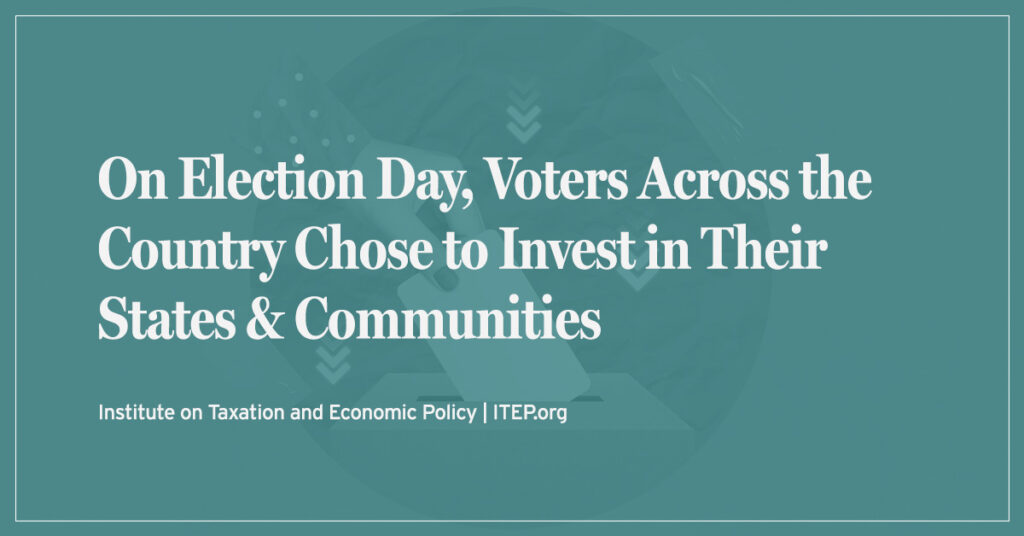The federal tax system and every state treat income from capital gains more favorably than income from work. Preferential capital gains tax treatment includes exclusions and seldom-discussed provisions like deferral and stepped-up basis, as well as more direct tax subsidies for profits realized from local investments and, in some instances, from investments around the world. This policy brief explains state capital gains taxation, examines the flaws in state capital gains tax breaks, and proposes reform options that will help make state tax systems more progressive and more equitable.
What Are Capital Gains?
Capital gains are profits from the sale of assets such as stocks, bonds, real estate, and antiques. Under a provision known as “deferral,” income tax on capital gains is paid only when the asset is sold. Thus, a stockholder who owns a stock over many years does not pay any tax as it increases in value each year in sharp contrast to income from work, which is taxed each year. If the stock is sold during the investor’s lifetime, the “realized” capital gain is calculated by taking the difference between the original buying price or “basis” and the selling price.
Federal tax law and some states recognize two different types of capital gains: short-term and long-term. Short-term capital gains are generally defined as gains realized on assets owned for less than one year. Most capital gains tax breaks are designed to reward long-term assets—those held for more than one year—only.
Who Receives Capital Gains?
According to the Internal Revenue Service (IRS), only 9 percent of Americans reported net capital gains income on their federal tax returns in 2017—and the vast majority of these gains were realized by the very wealthiest Americans. In particular:
- Taxpayers with federal adjusted gross incomes (AGI) in excess of $200,000 reported close to 84 percent of taxable capital gains, even though they accounted for just over 2 percent of all returns filed.
- The very wealthiest 0.1 percent of Americans—taxpayers with AGI over $2 million—received more than half, or 54 percent, of all capital gains income.
- The poorest three-fourths of the population—taxpayers with AGI of $75,000 or below— collectively received less than 6 percent of all capital gains income.
- Capital gains are primarily received by white households. Approximately 6.5 percent of Black households and 5.9 percent of Hispanic households own stocks and mutual fund shares, compared to 23.5 percent of white, non-Hispanic households.
In fact, capital gains are among the most unequally distributed sources of personal income. One obvious consequence of this concentration of capital gains income is that any “across the board” capital gains tax cut will dramatically reduce the share of income taxes paid by the very wealthiest taxpayers—and shift the tax system’s impact more heavily onto lower- and middle-income taxpayers.
Federal Law Provides Large Capital Gains Tax Breaks
Throughout its existence, the federal income tax has offered special treatment for long-term capital gains through policies such as deferral. More visible tax subsidies for capital gains have often been added in the form of income tax deductions through which taxpayers can subtract some of their capital gains income from their taxable income before calculating their income tax. At other times, including currently, federal tax law has provided a special lower tax rate for capital gains.
One of the greatest achievements of the federal Tax Reform Act of 1986 was to dramatically narrow these special preferences, taxing realized capital gains at the same rate as wages, dividends, and other income. (Previously, 60 percent of realized capital gains had been exempt.) In the years after 1986, however, Congress gradually reintroduced special tax preferences for capital gains income. In 2003, for example, President George W. Bush signed legislation that gradually reduced the top tax rate on long-term capital gains to just 15 percent—less than half the top rate on regular earned income.
Following the expiration of that cut and the creation of an additional 3.8 percent “net investment income tax” to fund health care reform under President Barack Obama, the rate on long-term capital gains income has since risen to 23.8 percent. While this increase represents an incremental improvement, the large discrepancy between tax rates on earned income versus capital gains shifts the federal income tax away from wealthy investors and toward ordinary wage earners.
The enactment of the Tax Cuts and Jobs Act (TCJA), signed into law by President Donald Trump in late 2017, did not meaningfully change the treatment of capital gains. Since individual income tax rates were reduced, the highest rate at which short-term capital gains could be taxed—because they are treated as ordinary income—was reduced from 39.6 percent to 37 percent. TCJA, however, continued to give long-term capital gains preferential treatment.
Practices and Trends in State Capital Gains Taxation
Nine states (Arizona, Arkansas, Hawaii, Montana, New Mexico, North Dakota, South Carolina, Vermont, and Wisconsin) now provide their own income tax deductions or preferential rates for all long-term capital gains income. Other states—such as Connecticut, Idaho, Kansas, Kentucky, Louisiana, Maine, Maryland, Mississippi, Nebraska, New Jersey, North Carolina, and Oklahoma—offer tax reductions for realized gains from certain assets located solely within state boundaries, though some of these breaks have sparked legal questions relating to whether they unconstitutionally interfere with interstate commerce. Still, other states tailor their capital gains preferences toward specific industries, such as technology in Virginia and the farming industry in Iowa and Wisconsin.
State lawmakers around the country have taken differing approaches to capital gains tax preferences in recent years. In 2016, Arkansas increased its tax break to 50 percent of gains, which also includes a full exemption for gains in excess of $10 million, and in 2018 Arizona lawmakers looked to expand their already-generous capital gains deduction from 25 percent to 50 percent, but the measure died despite making it out of the House and Senate Finance Committee. Other states, however, have begun to reconsider such tax preferences. Vermont capped its capital gains exclusion at $350,000 in 2019, and in the same year in Connecticut, Senate leaders pushed for a 2 percent surcharge on their top rate of 6.99 percent, though the effort ultimately fell short.
The Folly of State Capital Gains Tax Preferences
As states struggle to cope with short- and long-term budget deficits and to devise strategies to promote economic development in a sustainable fashion, policymakers should assess whether preserving tax preferences for capital gains income is in the public interest. State capital gains tax breaks have several flaws that contribute to increased income inequality, including compounding the racial wealth gap.
First, state capital gains tax breaks are regressive. According to ITEP’s Who Pays? report, the vast majority of state tax structures are regressive, asking more of low- and moderate-income families than of the wealthy. Special tax breaks that favor investors’ capital gains income over wages and salaries earned by working families exacerbates this problem.
For instance, South Carolina’s 44 percent exclusion for all long-term capital gains income drains roughly $240 million from state coffers each year while providing no benefit to the vast majority of the state’s residents. More than 95 percent of the benefits of this exclusion flow to the wealthiest 20 percent of South Carolinians, and 65 percent flow to the top 1 percent of earners alone.
Second, because white, non-Hispanic households are three to four times more likely to own stocks and mutual fund shares, state capital gains tax breaks exacerbate underlying racial inequities in income and wealth.
Lastly, state capital gains tax preferences are a flawed strategy for economic growth. Given the consequences of capital gains tax breaks for both state budgets and tax fairness, it is only natural to wonder why states might include such preferences in their tax codes. The argument that proponents of preferential treatment for capital gains make most frequently is that it is necessary to foster investment and to spur economic growth. Yet, that argument is seriously flawed.
An array of experts—from economists within the federal government to non-partisan analysts outside it—agree: there is little connection between lower capital gains taxes and higher economic growth in either the short run or the long run. Whatever connection may exist is even more tenuous at the state level. A general state capital gains tax break is highly unlikely to benefit that state’s economy, since any new investment encouraged by the capital gains break could take place anywhere in the United States or the world.
Toward A More Sensible Approach to Taxing State Capital Gains
States can take to improve their capital gains tax policy. First and foremost, those offering generous tax deductions or preferential rates for realized capital gains income should curtail or, better yet, eliminate these policies. Recent examples include a successful effort by New Mexico lawmakers in 2019 to scale back a 50 percent deduction for net capital gains income to 40 percent instead.
More proactive reform options include:
- Eliminating or scaling back tax deferral for unrealized capital gains, which allows taxpayers to defer income tax on gains until assets are sold. Curtailing deferral can help to put investment income on a more even footing with income from work, which is already taxed annually, and eliminating deferral altogether—also known as “mark-to-market” taxation—puts those two types of income on truly level footing;
- Ending step-up in basis, which, when combined with deferral, allows a large portion of capital gains income to go untaxed entirely. Investors holding assets until their death never pay capital gains tax on the appreciation of those investments. Step-up in basis allows heirs to those fortunes to escape capital gains tax as well because their “basis” in the inherited property is equal to the fair market value at the time they inherited it, rather than the original purchase price;
- Treating carried interest—which is a contractual structure that allows asset managers to be taxed at the capital gains tax rate on compensation earned from managing their client’s business—the same as regular income. This loophole allows asset managers to personally benefit from capital gains tax preferences even though they are not investing their own money. The TCJA only slightly modified the treatment of carried interest, increasing the amount of time assets must be held to be considered long-term assets (and therefore receive preferential tax treatment) from one year to three years; and
- Finally, states should consider taxing capital gains at a higher rate than income from work. Doing so can help counteract the unjustified tax preferences provided to capital gains income by the federal government’s preferential rates and the combination of state and federal deferral policies. In Massachusetts, for example, short-term capital gains are taxed at a higher rate of 12 percent compared to 5 percent for ordinary income—an approach that should be extended to long-term capital gains income as well.
Since most states conform to the federal tax code, the first three of these reforms could most effectively be enacted by congressional action, though some states would need to take action to ensure they were coupled to any federal changes. Absent congressional action, states can achieve these goals by passing legislation that moves their own treatment of capital gains income beyond the flawed treatment found in the federal tax code.
Conclusion
Income inequality and racial inequities are not passive forces in America, and state lawmakers should do their part to ensure that their tax codes are actively working to reverse them. One of the clearest places to start is with the tax treatment of capital gains income. Appropriate taxation of income from capital gains is an important element of improving the equity of state and local tax systems—the majority of which are regressive whereby those with lower income pay a higher share of their income in taxes.
Capital gains tax preferences are costly, inequitable, and ineffective, depriving states of millions of dollars in needed funds, benefitting almost exclusively the very wealthiest members of society, and failing to promote economic growth in the manner their proponents claim. States cannot afford to maintain these tax breaks any longer, and lawmakers considering introducing or expanding these regressive policies should understand the fairness and revenue implications before perpetuating or allowing these seriously flawed policies into their tax codes.
Bringing state capital gains taxes more closely into alignment with existing taxes on income from work offers a better path forward. Ending deferral and step-up basis could help achieve this goal, as could increasing tax rates on capital gains income to offset the noxious effects of the federal government’s preferential rates for capital gains income.





